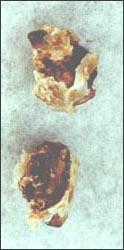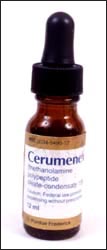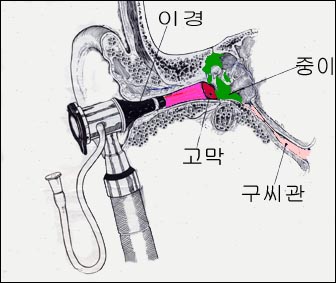귀지(이구/귓밥), Ear wax(Cerumen)

사진 41. 환아 외이도 속에서 꺼낸 큰 귀지.
귀지가 딱딱하게 굳을 수 있고, 퍼석퍼석하게 뭉쳐있을 수 있고, 물렁물렁할 수 있다.
Copyright ⓒ 2013 John Sangwon Lee, M.D., FAAP

사진 42. 귀지가 많이 있거나 굳어 문제가 생기면 의사의 지시에 따라 Cerumenex 외이도 점적약제를 외이도 속에 넣은 후 수분 내지 한두 시간 후 귀지를 물로 씻어내는 기구로 귀지를 제거할 수 있다. 귀지로 외이도가 막히면 이구전색이라고 한다.
Copyright ⓒ 2013 John Sangwon Lee, M.D., FAAP
- 땀샘과 피부 지방선(피지선)이 외이도 내 피부 층에 정상적으로 있다.
- 외이도 내 피부층 땀샘에서 땀이 나고 피부 지방선(피지선)에서 피부 지방이 정상으로 분비된다. 거기다가 피부 층의 각질층에서 떨어져 나온 각질이 합쳐 외이도 내 귀지가 정상적으로 계속 만들어진다.
- 귀지에는 여러 종류가 있다.
- 기름기가 많고
-
- 부드러운 귀지,
- 기름기가 적고 건조한 귀지,
- 부드러운 귀지,
- 딱딱한 귀지 등이 있다.
- 일부 아이들의 외이도 내 귀지가 거의 없고, 또 다른 아이들의 외이도 내 귀지가 너무 많아 외이도 내를 거의 다 막아 이구전색이 생긴다.
- 귀지(이구)가 생후 9개월 이전 영아들의 외이도 속에 많이 차 있다. 그래서 외이도 내, 고막, 중이 등을 진찰할 때 외이도 내 귀지를 제거 한 후 적절히 진찰할 수 있다.
- 급성 중이염이 있는 환아들의 외이도, 고막, 중이를 이경으로 진찰할 때 30% 경우, 외이도 내 귀지를 제거한 후, 이경을 통해 외이도 내와 고막을 자세히 진찰 할 수 있고 중이 강 속에 중이염이 있는지 없는지 진단을 할 수 있다14.

그림 43. 외이도와 중이 등을 진찰할 때 쓰는 이경(귀 직달경).
출처-American Family Physician, May 1979
- 귀지 형태와 모양은 인종과 개인에 따라 다르다.
- 외이도 내 귀지는 평상시 귓구멍 밖으로 자연적으로 밀려나오는 것이 정상이다. 그렇지만 어떤 아이들의 귀지는 외이도 내에서 팥알 크기내지 콩알 크기만 하게 굳게 뭉쳐진 상태로 외이도 내에 꼭 박혀 있다.
- 그런 귀지가 점점 더 커져 외이도 내를 완전히 막아 남의 말도 정상적으로 잘 들을 수 없다.
- 이렇게 딱딱하게 굳은 귀지를 “이구전색(Obstructive cerumen)”이라고 한다.
- 수영이나 목욕을 할 때 외이도 내 가득 찬 귀지가 물로 불면 외이도 속이 더 막힐 수 있고 몹시 가렵고 외이도염이 생길 수 있다.
- 귀지가 외이도 내 조금 들어 있을 때는 그대로 두고 관찰하는 것도 좋으나 가득 차 있는 이구전색은 적절한 치료를 받아야 한다.
- 이경을 통해 외이도 속을 눈으로 직접 들여다보지 않고 귀지가 외이도 내에 있는지 없는지, 있다면 얼마나 있는지, 외이도 속 어느 부위에 있는지 확실히 알 수 없다. 또 귀지가 얼마나 굳은지 그렇지 않으면 푸석푸석한지 확실히 알 수 없다.
- 이런 이유로 부모가 집에서 성냥개비나 머리핀 또는 면봉 등으로 외이도 내 귀지를 후벼내서는 안 된다.
- 외이도 내 귀지가 조금 있거나 많이 있어도 아무 증상이 없으면 귀지를 파내지 말고 그대로 두면 자연히 나올 수 있다.
- 그렇지만 귀지로 외이도 속이 가렵거나 아프거나 말을 잘 알아듣지 못하면 위에서 설명한 대로 의사의 치료를 받는다.
- 귀지가 외이도 내에 가득 차서 난청이 생기든지 귀가 아프든지 가려울 때는 의사의 처방에 따라 과산화수소(H₂O₂)액제나 베이킹 소다 액 또는 귀지 제거에 쓰는 다른 종류의 약물 몇 방울을 1일 2~3회 귀지가 차 있는 외이도 내에 넣으면 귀지가 부드러워진다.
- 흡인구 내 물을 외이도 내에 넣어 귀지를 씻어낼 수 있다.
- 그렇지만 외이도 내 다른 이상이 있는지, 귀지만 있는지 확실히 모르는 상태에서 집에서 처치해서는 안 된다.
- 소아청소년과에서 외이도 속을 이경으로 진찰한 후 귀지를 큐레트로 꺼내든지 세루메넥스 귀 접적애제 (CERUMENEX ear drops/Triethanolamine polypeptide), 두코세이트 점적약제(Docusate sodium ear drops), 과산화수소액, 베이킹 소다액, 또는 생리 식염수 등 중 한 가지를 선택해서 귀지를 꺼낼 수 있다.
- 이상 귀 점적액제 몇 방울을 외이도 내에 넣은 후 15분 정도 지나면 귀지가 촉촉해지고 물렁물렁해지면 귀지 닦아내는 의료 기구로 귀지를 씻어낼 수 있다. 이때도 의사가 이경으로 진찰하면서 귀지를 씻어낸다.
- 외이도 내나 귓구멍 속이 아프거나 외이도 속에서 고름이 나올 때는 외이도 내에 물이나 약물을 함부로 넣어서는 절대로 안 된다.
- 확대 렌즈와 불빛을 비춰 외이도를 볼 수 있는 큐렛 의료기구(Lighted ear curette magnifying lens)를 이용해 귀지를 제거해 낼 수 있다. Waterpik ear lavage system으로 귀지를 씻어낼 수 있다. [부모도 반의사가 되어야 한다-소아가정간호백과]-제 21권 소아청소년 가정간호-귓구멍 내에 이 점적약제(귀 방울약)를 넣는 방법 참조.
Ear wax (Cerumen)

Photo 41. Large earwax taken out from the ear canal of the patient. Earwax can be hard, crumbly, and soft. Copyright ⓒ 2013 John Sangwon Lee, M.D., FAAP

Photo 42. If there is a lot of earwax or hardening, according to the doctor’s instructions, insert the Cerumenex external ear canal dropper into the ear canal, and then after a few minutes or an hour or two, you can remove the earwax with a device to rinse the earwax with water. When the ear canal is blocked with earwax, it is called an ear canal. Copyright ⓒ 2013 John Sangwon Lee, M.D., FAAP
• Sweat glands and skin fat glands (sebaceous glands) are normally present in the skin layer in the ear canal.
• Sweat is produced in the skin layer sweat glands in the ear canal, and skin fat is normally secreted from the skin fat glands (sebaceous glands). In addition, the dead skin cells from the stratum corneum of the skin layer combine to form earwax in the ear canal normally.
• There are several types of earwax.
• oily
o soft earwax,
o Oily, dry earwax,
o soft earwax,
o Hard earwax, etc.
• Some children have almost no earwax in their ear canal, and some children have too much earwax in their ear canal, which almost completely blocks the inside of the ear canal.
• There is a lot of earwax in the ear canal of infants before 9 months of age. Therefore, when examining the inner ear canal, eardrum, middle ear, etc., it is possible to properly examine the earwax after removing the earwax.
• When examining the external auditory canal, tympanic membrane, and middle ear in 30% of children with acute otitis media, after removing the earwax in the external auditory canal, the inside of the external auditory meatus and the tympanic membrane can be examined in detail through the otoscope, and whether or not there is otitis media can do 14.

Figure 43. Otoscope used to examine the outer ear canal and middle ear. Source – American Family Physician, May 1979 • Earwax shape and shape vary by race and individual.
• It is normal for earwax in the ear canal to naturally protrude out of the ear canal. However, some children’s earwax is firmly embedded in the ear canal in a state the size of a red bean or a pea in the ear canal.
• The earwax gets bigger and bigger and completely blocks the inside of the ear canal, making it difficult to hear other people normally.
• This hardened earwax is called “Obstructive cerumen”.
• If the earwax that is filled with water in the ear canal is blown out while swimming or bathing, the inside of the ear canal can become more clogged, itchy and can cause otitis externa.
• If there is a small amount of earwax in the ear canal, it is good to leave it as it is, but if the earwax is full, appropriate treatment should be obtained. • Without looking directly into the ear canal through an otoscope, it is impossible to know for sure whether or not the earwax is in the ear canal, how much there is, and wherein the ear canal it is. Also, you cannot know for sure how hard the earwax is or if it is crumbly.
• For this reason, parents should not use matchsticks, hairpins, or cotton swabs to clean earwax in the ear canal at home. • If there is little or a lot of earwax in the ear canal and there are no symptoms, it can come out naturally if you leave it as it is without digging it out.
• However, if earwax causes itching or pain in the ear canal or difficulty understanding speech, seek medical attention as described above.
• When earwax is full in the ear canal, causing hearing loss, ear pain, or itching, according to the doctor’s prescription, apply a few drops of hydrogen peroxide (H₂O₂) solution, baking soda solution, or other types of drugs used to remove earwax 2-3 times a day. The earwax softens when placed in the filled ear canal.
• Earwax can be washed out by putting water in the suction port into the ear canal.
• However, it should not be treated at home without being sure if there are other abnormalities in the ear canal or only the ear canal. • After examining the inside of the ear canal with an otoscope at the Department of Pediatrics, remove the earwax with a curette or CERUMENEX ear drops/Triethanolamine polypeptide, Docusate sodium ear drops, hydrogen peroxide, and baking soda. You can take out the earwax by choosing either liquid or physiological saline.
• After putting a few drops of abnormal ear drops into the ear canal, after about 15 minutes, the earwax becomes moist and soft. Then, the earwax can be washed off with a medical device that wipes the earwax. At this time, the doctor examines with an otoscope and washes the earwax.
• When there is a pain in the ear canal or inside the ear canal, or when pus comes out from the ear canal, never put water or drugs into the ear canal.
• Earwax can be removed using a magnifying lens and a lighted ear curette magnifying lens that shines light to view the ear canal. Earwax can be washed away with the Waterpik ear lavage system. [Parents should also become at least the half-doctors-Children’s Home Nursing Encyclopedia]-Volume 21 Home Nursing for Children and Adolescents-See how to put this drop medicine (ear drops) into the ear canal.
출처 및 참조 문헌 Sources and references
- NelsonTextbook of Pediatrics 22ND Ed
- The Harriet Lane Handbook 22ND Ed
- Growth and development of the children
- Red Book 32nd Ed 2021-2024
- Neonatal Resuscitation, American Academy of Pediatrics
- www.drleepediatrics.com 제1권 소아청소년 응급 의료
- www.drleepediatrics.com 제2권 소아청소년 예방
- www.drleepediatrics.com 제3권 소아청소년 성장 발육 육아
- www.drleepediatrics.com 제4권 모유,모유수유, 이유
- www.drleepediatrics.com 제5권 인공영양, 우유, 이유식, 비타민, 미네랄, 단백질, 탄수화물, 지방
- www.drleepediatrics.com 제6권 신생아 성장 발육 육아 질병
- www.drleepediatrics.com제7권 소아청소년 감염병
- www.drleepediatrics.com제8권 소아청소년 호흡기 질환
- www.drleepediatrics.com제9권 소아청소년 소화기 질환
- www.drleepediatrics.com제10권. 소아청소년 신장 비뇨 생식기 질환
- www.drleepediatrics.com제11권. 소아청소년 심장 혈관계 질환
- www.drleepediatrics.com제12권. 소아청소년 신경 정신 질환, 행동 수면 문제
- www.drleepediatrics.com제13권. 소아청소년 혈액, 림프, 종양 질환
- www.drleepediatrics.com제14권. 소아청소년 내분비, 유전, 염색체, 대사, 희귀병
- www.drleepediatrics.com제15권. 소아청소년 알레르기, 자가 면역질환
- www.drleepediatrics.com제16권. 소아청소년 정형외과 질환
- www.drleepediatrics.com제17권. 소아청소년 피부 질환
- www.drleepediatrics.com제18권. 소아청소년 이비인후(귀 코 인두 후두) 질환
- www.drleepediatrics.com제19권. 소아청소년 안과 (눈)질환
- www.drleepediatrics.com 제20권 소아청소년 이 (치아)질환
- www.drleepediatrics.com 제21권 소아청소년 가정 학교 간호
- www.drleepediatrics.com 제22권 아들 딸 이렇게 사랑해 키우세요
- www.drleepediatrics.com 제23권 사춘기 아이들의 성장 발육 질병
- www.drleepediatrics.com 제24권 소아청소년 성교육
- www.drleepediatrics.com 제25권 임신, 분만, 출산, 신생아 돌보기
- Red book 29th-31st edition 2021
- Nelson Text Book of Pediatrics 19th- 21st Edition
- The Johns Hopkins Hospital, The Harriet Lane Handbook, 22nd edition
- 응급환자관리 정담미디어
- Pediatric Nutritional Handbook American Academy of Pediatrics
- 소아가정간호백과–부모도 반의사가 되어야 한다, 이상원 저
- The pregnancy Bible. By Joan stone, MD. Keith Eddleman, MD
- Neonatology Jeffrey J. Pomerance, C. Joan Richardson
- Preparation for Birth. Beverly Savage and Dianna Smith
- 임신에서 신생아 돌보기까지. 이상원
- Breastfeeding. by Ruth Lawrence and Robert Lawrence
- Sources and references on Growth, Development, Cares, and Diseases of Newborn Infants
- Emergency Medical Service for Children, By Ross Lab. May 1989. p.10
- Emergency care, Harvey Grant and Robert Murray
- Emergency Care Transportation of Sick and Injured American Academy of Orthopaedic Surgeons
- Emergency Pediatrics A Guide to Ambulatory Care, Roger M. Barkin, Peter Rosen
- Quick Reference To Pediatric Emergencies, Delmer J. Pascoe, M.D., Moses Grossman, M.D. with 26 contributors
- Neonatal resuscitation Ameican academy of pediatrics
- Pediatric Nutritional Handbook American Academy of Pediatrics
- Pediatric Resuscitation Pediatric Clinics of North America, Stephen M. Schexnayder, M.D.
-
Pediatric Critical Care, Pediatric Clinics of North America, James P. Orlowski, M.D.
-
Preparation for Birth. Beverly Savage and Dianna Smith
-
Infectious disease of children, Saul Krugman, Samuel L Katz, Ann A.
- 제4권 모유, 모유수유, 이유 참조문헌 및 출처
- 제5권 인공영양, 우유, 이유, 비타민, 단백질, 지방 탄수 화물 참조문헌 및 출처
- 제6권 신생아 성장발육 양호 질병 참조문헌 및 출처
- 소아과학 대한교과서
-
제18권 소아청소년 이비인후과 질환 참조문헌 및 출처
-
Emergency Care Transportation of Sick and Injured American Academy of Orthopaedic Surgeons
-
Emergency Pediatrics A Guide to Ambulatory Care, Roger M. Barkin, Peter Rosen
-
Gray’s Anatomy
-
Habilitation of The handicapped Child, The Pediatric Clinics of North America, Robert H Haslam, MD.,
-
Pediatric Otolaryngology Sylvan Stool
-
Hearing Loss In children, The Pediatric Clinics of North America Nancy Roizen,MD and Allan O Diefendorf, PhD
-
Recent Advances in Pediatric otolaryngology The Pediatric Clinics of North America
-
Pediatric Otolaryngology. The Pediatric Clinics of North America, David Tunkel, MD., Kenneth MD Grundfast, MD
Copyright ⓒ 2014 John Sangwon Lee, MD., FAAP
“부모도 반의사가 되어야 한다”-내용은 여러분들의 의사로부터 얻은 정보와 진료를 대신할 수 없습니다.
“The information contained in this publication should not be used as a substitute for the medical care and advice of your doctor. There may be variations in treatment that your doctor may recommend based on individual facts and circumstances.
“Parental education is the best medicine.